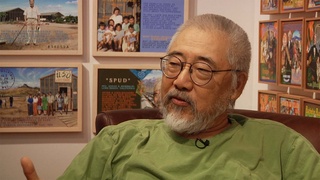Interviews
Conditions of assembly centers
We were sent to an assembly center because the relocation camps, which we later called concentration camps, weren’t built. But, they use for assembly centers, they used—what d’you call it—racetracks and fairgrounds. And, I don’t know, there were about, I think they said about 16 of those places. And, well we were sent to Santa Anita, which is the largest—it had almost 20,000 there—and it’s a racetrack. And so, most of us were billeted in the horse stalls. And, I think at fairgrounds it was the same thing—they had horses, too, I guess. So, they stayed in, what d’you call, horse stalls, too. Lot of the Isseis started getting sick because of the horse manure, that, you know, you smell and you see there.
Date: June 16, 2003
Location: California, US
Interviewer: Karen Ishizuka, Akira Boch
Contributed by: Watase Media Arts Center, Japanese American National Museum.

